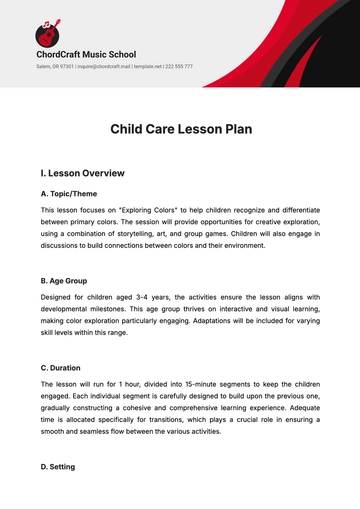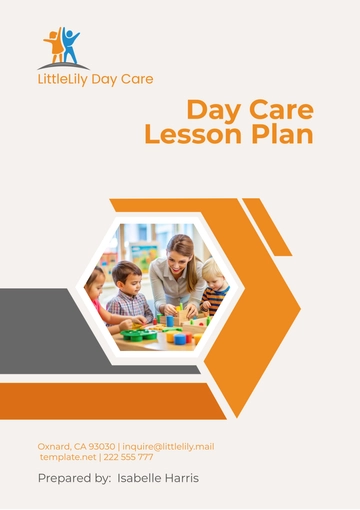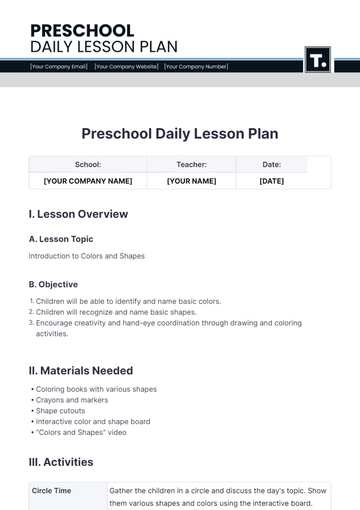Free Day Care Lesson Plan

1. Introduction
At [Your Company Name], we are dedicated to providing a nurturing and stimulating environment where children can thrive and develop holistically. Our day care program is designed to cater to the diverse needs of children aged 0-5 years, fostering their cognitive, emotional, social, and physical development through a variety of engaging activities. Each lesson is crafted to promote exploration and creativity, ensuring that every child feels valued and supported in their learning journey.
We believe that early childhood education is not just about imparting knowledge but also about building strong foundations for lifelong learning. Our educators are trained to create an atmosphere of curiosity, allowing children to explore the world around them safely and confidently. This period of growth is critical, and we take pride in our ability to guide children through their developmental milestones with care and enthusiasm. By fostering an environment where play is recognized as an essential component of learning, we aim to inspire a love for discovery that lasts a lifetime.
2. Goals and Objectives
2.1. Overall Goals
To create a safe and inclusive environment that encourages curiosity and self-expression.
We aim to provide a space where all children feel secure and valued, enabling them to explore their interests freely. This environment promotes self-confidence and the willingness to engage with others.To promote positive social interactions among children, fostering friendships and cooperation.
By encouraging collaborative activities, we help children learn the importance of teamwork and empathy. Friendships formed in early childhood can lay the groundwork for future social skills and relationships.To develop essential life skills that empower children to navigate their world confidently.
We strive to equip children with problem-solving abilities, critical thinking skills, and emotional intelligence. These skills are vital for their success in school and beyond.
2.2. Specific Objectives
Children will demonstrate improved fine and gross motor skills through various hands-on activities.
Engaging in tasks like cutting with scissors, building with blocks, and participating in physical games will help refine their motor skills, promoting coordination and strength.Children will engage in cooperative play, enhancing their social skills and ability to work as a team.
Through structured games and group projects, children will learn to share, negotiate, and collaborate, which are crucial skills for their future social interactions.Children will express their thoughts and feelings verbally, improving their communication skills.
By participating in group discussions and storytelling, children will practice articulating their ideas and emotions, boosting their confidence in expressing themselves.
3. Daily Schedule
Our daily schedule is thoughtfully designed to balance structured activities with free play, ensuring that children have opportunities for both guided learning and self-directed exploration. This balance supports their natural curiosity and allows them to engage in the learning process at their own pace, accommodating varying attention spans and interests.
Time | Activity | Description |
|---|---|---|
8:00 - 9:00 | Arrival & Free Play | Children arrive and engage in free play to ease into the day. This time allows them to connect with peers and settle comfortably, establishing a positive mood for the day. Educators use this opportunity to greet each child individually, fostering a sense of belonging. |
9:00 - 9:30 | Morning Circle | A group gathering where children share their thoughts and feelings. This promotes community and encourages children to listen to each other. The circle time may include songs, movement activities, or discussions about the day’s theme, fostering excitement for the activities ahead. |
9:30 - 10:00 | Snack Time | A healthy snack is provided to refuel energy and encourage social interaction among peers. This fosters conversations and friendship-building, as children share their favorite snacks and learn about healthy eating habits. |
10:00 - 11:00 | Structured Learning Activities | Focused activities that align with developmental objectives, fostering skills in literacy, numeracy, and social-emotional growth. These activities are tailored to the children's interests, allowing them to engage deeply and meaningfully. |
11:00 - 12:00 | Outdoor Play | Engaging in outdoor activities that promote physical health and exploration of the natural environment. This is crucial for developing gross motor skills and provides an opportunity for sensory experiences. Outdoor play encourages risk-taking and resilience as children navigate different terrains and play structures. |
12:00 - 1:00 | Lunch and Relaxation | Time for children to enjoy their lunch while socializing with their peers, followed by a quiet time to recharge. This break is essential for their overall well-being, helping to reduce stress and restore energy for the afternoon activities. |
1:00 - 2:00 | Story Time | An interactive storytelling session that captivates children’s imaginations and enhances language skills. This activity helps to develop listening skills and encourages children to think critically about narratives. |
2:00 - 3:00 | Creative Arts and Crafts | Activities designed to spark creativity through various art mediums, allowing children to express themselves in unique ways. Through these activities, children explore colors, shapes, and textures, enhancing their sensory development. |
3:00 - 4:00 | Closing Circle & Departure | A reflective circle where children share their favorite moments from the day before heading home, fostering a sense of community. This time allows educators to recap the day’s learning and set a positive tone for tomorrow. |
4. Activity Descriptions
4.1. Arrival & Free Play
During the arrival and free play period, children are welcomed warmly as they come in. This unstructured time is crucial for building a sense of belonging, as it allows them to choose activities that interest them. Educators circulate the space, offering support and guidance while encouraging social interactions among children. By allowing children to play freely, they develop essential social skills such as sharing, taking turns, and problem-solving. The variety of available toys and materials allows children to explore different roles and scenarios, fostering creativity and imagination.
4.2. Morning Circle
The morning circle is a vital part of the daily routine, where children gather to share news, feelings, and thoughts. This practice not only builds a sense of community but also enhances verbal communication skills as children practice listening and responding to their peers. Educators lead discussions on topics related to current themes, helping children make connections to their experiences. For instance, if the theme is nature, children can share observations from their outdoor playtime. This interaction encourages respect for different viewpoints and promotes empathy among children.
4.3. Structured Learning Activities
Structured learning activities are tailored to the developmental levels of the children. These activities are designed to stimulate critical thinking, creativity, and problem-solving skills. For example, during a literacy session, children may engage in phonics games or storytelling exercises that promote their understanding of language. Through hands-on activities, such as building blocks or simple math games, children develop cognitive skills in a playful manner. By integrating multi-sensory experiences, such as using tactile materials, children are able to grasp concepts more effectively.
4.4. Story Time
Story Time is an essential part of the day, promoting language development, comprehension skills, and a love for reading. This activity allows children to engage with literature in a fun and interactive way.
4.4.1. Objectives
To enhance vocabulary and listening skills by introducing children to new stories and ideas.
By exposing children to a range of vocabulary and narrative structures, they become more adept at understanding language nuances.To encourage imagination and creativity through discussions about characters and storylines.
Engaging children in dialogue about the plot and characters fosters critical thinking and personal connection to the material.
4.4.2. Activities
Book Selection:
Choose engaging books with colorful illustrations and relatable characters. Encourage children to help select the book, promoting ownership and interest in the story. This choice fosters a love for reading and allows children to explore different themes and genres. Including diverse representations in the books helps children connect with characters that reflect their own lives.Interactive Storytelling:
Use props or puppets to act out parts of the story, making it more engaging. Children are invited to participate by mimicking actions or sounds, enhancing engagement and retention. This interactive approach helps children connect emotionally with the story, deepening their comprehension and enjoyment.Discussion Questions:
Ask open-ended questions related to the story. For example, “What would you do if you were in that situation?” This encourages critical thinking and helps children articulate their thoughts, making connections between the story and their own lives. This practice also enhances their ability to express complex ideas and fosters a sense of confidence in their opinions.
4.5. Outdoor Play
Outdoor play is vital for promoting physical health and social interaction. It provides children with opportunities to engage in physical activities and explore their environment.
4.5.1. Objectives
To enhance gross motor skills through running, jumping, and climbing activities.
Activities designed for outdoor play enable children to test their physical capabilities, build muscle strength, and improve coordination.To encourage cooperative play and social skills through games and group activities.
Through structured games, children learn how to work together toward common goals, fostering a sense of teamwork and community.
4.5.2. Outdoor Activities
Activity | Description |
|---|---|
Obstacle Course | Set up a course with cones, tunnels, and balance beams to promote physical challenges. Children navigate through the course, enhancing coordination and motor skills. |
Group Games (e.g., Tag) | Engaging in classic games fosters social interaction and encourages children to follow rules and develop strategy. This helps in building friendships and enhancing communication skills. |
Nature Exploration | Organize scavenger hunts to encourage observation and exploration of the natural world. This activity connects children to their environment, sparking curiosity and an appreciation for nature. |
5. Assessment and Evaluation
5.1. Observation Techniques
Regular observation is essential for assessing each child's development and identifying areas where they may need additional support. Educators document observations using anecdotal records, checklists, and photographs. This information informs lesson planning and helps tailor activities to meet individual needs.
5.2. Assessment Methods
Portfolio Assessment:
A collection of each child's work and progress, including art projects, photos, and samples of written work, is maintained. Portfolios provide a comprehensive view of each child's growth over time, showcasing their skills and achievements. They also serve as a wonderful tool for parents to witness their child's development journey.Parent-Teacher Conferences:
Regular meetings with parents to discuss their child's progress and share observations. These conferences foster a partnership between educators and families, allowing for open communication regarding the child’s growth and development. This collaborative approach ensures that children receive consistent support both at home and in the daycare setting.Developmental Checklists:
Utilizing standardized developmental checklists to assess children against developmental milestones ensures that all areas of growth are being monitored. This method allows educators to identify any concerns early and make appropriate adjustments to the learning plan.
6. Parent Involvement
6.1. Importance of Parent Engagement
Parent involvement is crucial to a child's success in the daycare environment. When parents actively participate in their child's education, it enhances their overall development and strengthens the home-school connection. Engaging parents in their children's learning fosters a sense of community and shared responsibility for their growth.
6.2. Strategies for Encouraging Participation
Regular Communication:
Maintaining open lines of communication through newsletters, emails, and parent meetings ensures that parents are informed and involved. This communication builds trust and allows parents to feel connected to the daycare community.Volunteering Opportunities:
Offering opportunities for parents to volunteer in the classroom or during events encourages active participation. This involvement allows parents to witness firsthand their child's experiences and promotes a sense of belonging within the community.Parent Workshops:
Organizing workshops on child development topics, parenting strategies, or early education practices empowers parents with knowledge and skills. These workshops create a collaborative atmosphere where parents can share experiences and learn from one another.
7. Resources and References
7.1. Recommended Reading
"The Whole-Brain Child" by Daniel J. Siegel and Tina Payne Bryson
This book offers insights into how a child's brain develops and provides strategies for nurturing emotional and intellectual growth."How Children Succeed" by Paul Tough
This book explores the importance of character and resilience in children's success, providing practical advice for fostering these qualities."The Power of Play" by David Elkind
This resource emphasizes the significance of play in child development and offers guidance on creating enriching play experiences.
7.2. Online Resources
NAEYC - National Association for the Education of Young Children
A valuable resource for early childhood educators, offering research-based information, best practices, and professional development opportunities.Zero to Three - Resources for Parents and Educators
This organization provides resources focused on early childhood development, helping educators and parents support children’s growth from birth to age three.CDC Developmental Milestones
The CDC’s guide on developmental milestones offers insights into expected developmental behaviors, helping caregivers understand and support their children's growth.
8. Conclusion
[Your Company Name] is committed to providing a high-quality daycare experience that fosters children's growth in a nurturing and engaging environment. Our lesson plan is designed to balance structure and free play, allowing children to explore their interests while also developing essential life skills. Through our carefully crafted activities, we aim to cultivate curiosity, creativity, and a lifelong love for learning.
By involving parents in their children's education and regularly assessing each child's development, we ensure that every child receives the support they need to thrive. As we look to the future, we remain dedicated to adapting our approaches and resources to meet the evolving needs of families and the ever-changing landscape of early childhood education. Together, we can create a bright and promising future for the children entrusted to our care.
- 100% Customizable, free editor
- Access 1 Million+ Templates, photo’s & graphics
- Download or share as a template
- Click and replace photos, graphics, text, backgrounds
- Resize, crop, AI write & more
- Access advanced editor
Plan educational activities with the Day Care Lesson Plan Template from Template.net. This editable and customizable template helps caregivers structure age-appropriate lessons that encourage learning and development. Tailor it using our Ai Editor Tool to support engaging day care programs.


